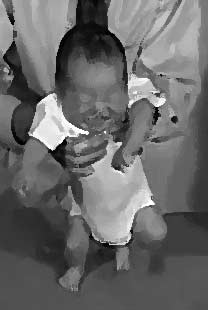Walking reflex
The walking reflex is a primitive reflex found in newborn humans, which is an automatic response that is present from birth and typically fades around the age of two months. This reflex is also known as the stepping reflex and demonstrates an infant's natural inclination towards locomotion. It is an important indicator of neurological development and is used by pediatricians to assess the health and development of the central nervous system in infants.
Overview[edit | edit source]
When the soles of an infant's feet touch a flat surface while the child is held upright, the walking reflex causes the baby to mimic a stepping or walking motion. This reflex is thought to be a precursor to voluntary walking, helping to prepare the infant's muscles and coordination for independent walking later in life. The presence and strength of the walking reflex, along with other primitive reflexes, are important indicators of the integrity of the infant's nervous system.
Developmental Significance[edit | edit source]
The walking reflex is one of several primitive reflexes that are present at birth and diminish as the baby grows. These reflexes are not learned behaviors but are innate motor responses that facilitate survival and development in the early stages of life. The disappearance of the walking reflex is a normal part of neurological development, making way for more controlled and voluntary movements as the infant's motor skills mature.
Assessment[edit | edit source]
Pediatricians assess the walking reflex as part of a newborn's neurological examination. The assessment involves supporting the infant in an upright position with their feet touching a flat surface. A positive response is observed when the infant lifts one foot and then the other in a stepping motion. The absence or asymmetry of this reflex may prompt further neurological evaluation to rule out any underlying conditions.
Clinical Relevance[edit | edit source]
While the walking reflex is a normal part of infant development, its absence, delay, or asymmetry can be indicative of neurological problems. Conditions such as cerebral palsy, spinal cord injuries, or other motor neuron diseases may affect the presence or strength of the reflex. Therefore, monitoring the reflex is crucial in the early detection and intervention of such conditions.
Conclusion[edit | edit source]
The walking reflex is a fascinating aspect of infant development, showcasing the innate capabilities and complexities of the human nervous system. Understanding and monitoring this reflex is essential for ensuring the healthy development of infants and for the early detection of potential neurological issues.
Translate: - East Asian
中文,
日本,
한국어,
South Asian
हिन्दी,
தமிழ்,
తెలుగు,
Urdu,
ಕನ್ನಡ,
Southeast Asian
Indonesian,
Vietnamese,
Thai,
မြန်မာဘာသာ,
বাংলা
European
español,
Deutsch,
français,
Greek,
português do Brasil,
polski,
română,
русский,
Nederlands,
norsk,
svenska,
suomi,
Italian
Middle Eastern & African
عربى,
Turkish,
Persian,
Hebrew,
Afrikaans,
isiZulu,
Kiswahili,
Other
Bulgarian,
Hungarian,
Czech,
Swedish,
മലയാളം,
मराठी,
ਪੰਜਾਬੀ,
ગુજરાતી,
Portuguese,
Ukrainian
Navigation: Wellness - Encyclopedia - Health topics - Disease Index - Drugs - World Directory - Gray's Anatomy - Keto diet - Recipes
Search WikiMD
Ad.Tired of being Overweight? Try W8MD's physician weight loss program.
Semaglutide (Ozempic / Wegovy and Tirzepatide (Mounjaro / Zepbound) available.
Advertise on WikiMD
WikiMD is not a substitute for professional medical advice. See full disclaimer.
Credits:Most images are courtesy of Wikimedia commons, and templates Wikipedia, licensed under CC BY SA or similar.Contributors: Prab R. Tumpati, MD

